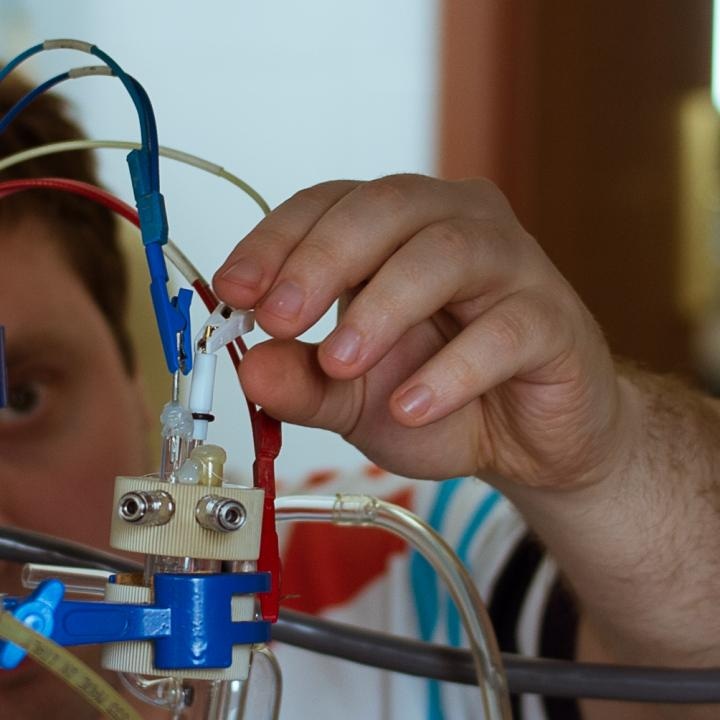Aug 2 2017
Lithium-air batteries are devices, generating power merely out of air so they are also referred to lithium-oxygen batteries. Owing to higher energy density they are a lot lighter than lithium-ion ones.
Lithium-air batteries could prove to be a lot more desirable, for instance, for increasing driving range of electric cars on a single charge. However, regardless of all these benefits, industrial manufacture of lithium-air batteries has not begun yet since their designers face major problems which cannot be handled at the present.
 This is an electrochemical cell for the studies of mechanisms of processes, taking place in lithium-air batteries.(CREDIT - Alexei Khokhlov)
This is an electrochemical cell for the studies of mechanisms of processes, taking place in lithium-air batteries.(CREDIT - Alexei Khokhlov)
A lithium-air battery could potentially have specific energy, which is 3-5 times more than modern lithium-ion batteries. One of the main problems in such batteries' development is electrode passivation, which is transition of the electrode material surface into inactive state. We've obtained new data, concerning the reaction mechanism, and suggested some ideas on how to inhibit electrode passivation. One could use the technique, offered by us, for searching for more appropriate solvents, electrolytes and electrode materials.
Artem Sergeev, a Ph.D. Student from the Department of Polymer and Crystal Physics at the Solid-state Physics Division of the Faculty of Physics, Lomonosov Moscow State University, and a Co-author
Pure oxygen but not air, being a blend of atmospheric gases, is essential today for operation of lithium-air batteries. Carbon dioxide and moisture, found in air, hold up redox reactions, fundamental to the battery operation. By numerous estimates, surpassing these hurdles will take about 5 to 10 years. The Researchers from the Lomonosov Moscow State University examine the processes, preventing vigorous operation of lithium-air batteries.
Generally, in the case of elaboration success the battery should be lithium-air, implying usage of environmental air. Special membranes should separate its undesirable components (moisture, carbon dioxide). But currently there are also more fundamental problems and in order to solve them one usually applies to lithium-oxygen cells, where pure oxygen from gas bottles is delivered.
Alexei Khokhlov, Doctor of Physical and Mathematical Sciences, Academician of RAS, the Head of the Department of Polymer and Crystal Physics at the Faculty of Physics, Lomonosov Moscow State University and one of the Authors of the article
The cathode (a positive electrode) in a lithium-air battery is denoted by a porous carbon sponge, holding in its voids the electrolyte solution with lithium ions. The cathode contacts with the outside gas environment, what is required to provide oxygen delivery to the electrolyte, which is a liquid ion conductor. The Researchers have simulated the interface between the electrolyte solution and the electrode and at the cathode of a lithium-air battery and developed a method for obstructing electrode passivation.
The Researchers have used the supercomputer complex of the Lomonosov Moscow State University for all-atom simulation with the aid of molecular dynamics techniques.
Alexei Khokhlov explains: "There is quite a number of parallel processes and reactions, occurring at the cathode while lithium-air battery operates. Unfortunately, experimental study of separate stages of these processes often turns out to be impossible, while simulation of separate stages of the reactions with the help of supercomputers allows to trace basic trend in the stages of interest."
The Researchers have discovered that reduction of superoxide anion (a strong inorganic oxidizer - O2-), resulting in electrode passivation, is doable only after its binding with lithium cation.
We've understood that formation of non-conductive discharge products right on the electrode surface (its passivation) takes place only after binding of an intermediate (superoxide anion) with lithium ions, which concentration is high near the electrode surface. If you displace them out, passivation won't, probably, proceed so rapidly.
Alexei Khokhlov, Doctor of Physical and Mathematical Sciences, Academician of RAS, the Head of the Department of Polymer and Crystal Physics at the Faculty of Physics, Lomonosov Moscow State University and one of the Authors of the article
The project was conducted in cooperation with Researchers from Ulm University, Germany.